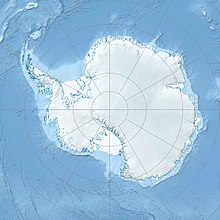Dome F
Coordinates: 77 ° 19 ′ S , 39 ° 42 ′ E
Dome F , also known as Dome Fuji (ド ー ム 富士Dōmu Fuji ) or Valkyrjedomen and Valkyrie Dome is an ice dome in the eastern Queen Maud Land . With a height of 3,810 m above sea level, Dome F is the second highest apex or "dome" of the Antarctic ice sheet and thus forms an ice divide . There is a Japanese research station there.
Scientists of the 9th Soviet Antarctic Expedition (1963-1965) under the direction of Mikhail Somov crossed the northern part of the ice dome at an altitude of 3600 m during their exploration of the Antarctic ice sheet carried out between 1963 and 1964 . Its extent was determined by sonar tracking as part of a joint program of the Scott Polar Research Institute , the National Science Foundation and Denmark's Technical University between 1967 and 1979. The Ice Dome is named in Norwegian and English after the Valkyrie from Nordic mythology .
climate
Due to its location on the high plateau of East Antarctica and the high altitude, Dome F is one of the coldest places on earth. The temperature rarely rises above −30 ° C in summer and can drop to −80 ° C in winter. In August 2020, the lowest temperature was measured at −93.2 ° C. The annual mean is −54.3 ° C. The climate is that of a cold desert , with very dry conditions and annual precipitation of around 25 millimeters of water equivalent, which falls exclusively as snow .
Dome Fuji Station
The Dome Fuji Station ( ド ー ム 富士 基地 , Dōmu Fuji Kichi ) was set up in January 1995 as the "Dome Fuji Observation Base " ( ド ー ム 富士 観 測 拠 点 , Dōmu Fuji Kansoku Kyoten ). The name was changed to “Dome Fuji Station” on April 1, 2004. The distance to the Shōwa station is about 1000 km.
glaciology
A deep ice hole was started at Dome F in August 1995 and reached a depth of 2503 meters in December 1996 . This first Dome-F core contains ice up to 340,000 years old.
The second deep core was started in 2003 . The drilling work extended over four consecutive southern summers from 2003/2004 to 2006/2007, advancing to a depth of 3035.22 m. The borehole did not reach the bedrock, but rock objects and re-frozen water were found in the bottom ice, which indicates that the borehole could at least have come very close to the bedrock. This drill core expands the climate archive of the first drill core considerably and, according to an initial and preliminary dating, goes back some 720,000 years into the continent's past. Thus, the ice from the second Dome-F drill core is the second oldest ice sample ever produced, only surpassed that of the Dome-C drill core .
See also
- Asuka station
- Mizuho station
- Dome A (also known as Dome Argus )
- Dome Charlie (also known as Dome Circe, Dome C, or Dome Concordia )
- EPICA
- Concordia station
- Kohnen station
- Vostok station
- Antarctic climate
Web links
- Dome Fuji Deep Ice Coring Project
- Dome Fuji page of the World Data Center (WDC) for Paleoclimatology , contains downloadable data from the first drill core
- National Institute of Polar Research , Tokyo, Japan
- Institute of Low Temperature Science , Sapporo, Japan
- COMNAP Antarctic Facilities ( Memento of August 7, 2011 in the Internet Archive ) (English)
- COMNAP Antarctic Facilities Map (English)
Individual evidence
- ^ Coldest places on Earth. Accessed April 25, 2020 (English).
- ^ O. Watanabe et al .: General tendencies of stable isotopes and major chemical constituents of the Dome Fuji deep ice core . In: Global scale climate and environmental study through polar deep ice cores . National Institute of Polar Research, Tokyo, Japan 2003, p. 1-24 .
- ^ Dome-F Deep Coring Group: Deep ice-core drilling at Dome Fuji and glaciological studies in east Dronning Maud Land, Antarctica . In: Annals of Glaciology . tape 27 , 1998, pp. 333-337 .
- ↑ K. Kawamura et al .: Northern Hemisphere forcing of climatic cycles in Antarctica over the past 360,000 years . In: Nature . tape 448 , 2007, p. 912-916 .
- ^ H. Motoyama: The second deep ice coring project at Dome Fuji, Antarctica . In: Scientific Drilling . tape 5 , 2007, p. 41-43 .

